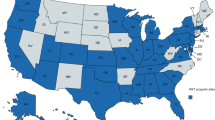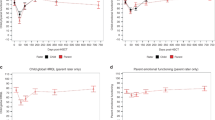Abstract
Medical and demographic variables were examined as predictors of acute health-related quality of life (HRQL), specifically, somatic distress, mood disturbance and activity levels, during the period of bone marrow transplant (BMT) hospitalization, and the transition phase in the months following hospital discharge. The responses of 153 children undergoing BMT were assessed by both parent report and patient self-report in a prospective longitudinal design. Type of transplant, diagnosis, age, gender, and socio-economic status (SES) were examined as predictor variables of patient outcome. Type of transplant, patient age, and SES emerged as significant determinants of patient response. Children undergoing unrelated donor (MUD) transplants experiencing the highest levels of distress, followed by those undergoing matched-sibling BMT, while those undergoing autologous transplant experienced the lowest levels of distress. Younger patients experienced lower levels of distress and better HRQL than older children and adolescents. Although patients from different SES backgrounds appeared very similar at the time of hospital admission, those from lower SES backgrounds demonstrated greater distress and disturbance in HRQL subsequently, and throughout the first 6 months post BMT. These findings help to target specific subgroups of patients that may be in greater need of preventive interventions or more aggressive supportive care.
Bone Marrow Transplantation (2002) 29, 435–442. doi:10.1038/sj.bmt.1703376
This is a preview of subscription content, access via your institution
Access options
Subscribe to this journal
Receive 12 print issues and online access
$259.00 per year
only $21.58 per issue
Buy this article
- Purchase on Springer Link
- Instant access to full article PDF
Prices may be subject to local taxes which are calculated during checkout



Similar content being viewed by others
References
Andrykowski MA . Psychosocial factors in bone marrow transplantation: a review and recommendations for research Bone Marrow Transplant 1994 13: 357 375
Anderson BL . Sexual functioning morbidity among cancer survivors: current status and future research directions Cancer 1985 55: 1835 1842
Wettergren L, Langius A, Bjorkholm M, Bjorvell H . Physical and psychosocial functioning in patients undergoing autologous transplantation – a prospective study Bone Marrow Transplant 1997 20: 497 502
Leigh S, Wilson KCM, Burns R, Clark RE . Psychosocial morbidity in bone marrow transplant recipients: a prospective study Bone Marrow Transplant 1995 16: 635 640
Sasaki T, Akaho R, Sakamaki H et al. Mental disturbances during isolation in bone marrow transplant patients with leukemia Bone Marrow Transplant 2000 25: 315 318
Hjermstad MJ, Loge JH, Evensen SA et al. The course of anxiety and depression during the first year after allogeneic or autologous stem cell transplantation Bone Marrow Transplant 1999 24: 1219 1228
Rodrigue JR, Graham-Pole J, Kury S et al. Behavioral distress, fear, and pain among children hospitalized for bone marrow transplantation Clin Transplant 1995 9: 454 456
Gunter M, Karle M, Werning A, Klingbiel T . Emotional adaptation of children undergoing bone marrow transplantation Can J Psychiatry 1999 44: 77 81
Syrjala KL, Chapko MK, Vitiliano PP et al. Recovery after allogeneic marrow transplantation: prospective study of predictors of long-term physical and psychosocial functioning Bone Marrow Transplant 1993 11: 319 327
Andrykowski MA, Brady MJ, Greiner CB et al. ‘Returning to normal’ following bone marrow transplantation: outcomes, expectations, and informed consent Bone Marrow Transplant 1995 15: 573 581
McQuellon RP, Russell GB, Rambo TD et al. Quality of life and psychological distress of bone marrow transplant recipients: the ‘time trajectory’ to recovery over the first year Bone Marrow Transplant 1998 21: 477 486
Baker F, Zabora J, Polland A, Wingard J . Reintegration after bone marrow transplantation Cancer Pract 1999 7: 190 197
Andrykowski MA, Bruehl S, Brady MJ, Henslee-Downey PJ . Physical and psychosocial status one year after bone marrow transplant: a prospective study Bone Marrow Transplant 1995 15: 837 844
Phipps S, Dunavant M, Garvie PA et al. Acute health-related quality of life in children undergoing stem cell transplant: I. Descriptive outcomes Bone Marrow Transplant 2002 29: 425 434
Hollingshead AB . Four Factor Index of Social Status Yale University Press: New Haven 1975
Diggle PJ, Liang KY, Zeger SL . Analysis of Longitudinal Data Oxford University Press: New York 1994
SAS Institute, Inc. SAS OnlineDoc, Version 8 SAS Institute Inc: Cary, NC 1999
Lipsitz SR, Kim K, Zhao L . Analysis of repeated categorical data using generalized estimating equations Stat Med 1994 13: 1149 1163
Samaan RA . The influences of race, ethnicity, and poverty on the mental health of children J Health Care Poor Underserved 2000 11: 100 110
Call KT, Nonnemaker J . Socioeconomic disparities in adolescent health: contributing factors Ann NY Acad Sci 1999 896: 352 355
Baum A, Garofalo JP, Yali AM . Socioeconomic status and chronic stress: does stress account for SES effects on health? Ann NY Acad Sci 1999 896: 131 144
Mitchell JM, Meehan KR, Kong J, Schulman KA . Access to bone marrow transplantation for leukemia and lymphoma: the role of sociodemographic factors J Clin Oncol 1997 15: 244 251
Norheim OF . Limiting access to allogeneic bone marrow transplantation in five European countries: what can we learn about implicit rationing? Health Policy 2000 52: 149 156
Richardson R, Waddington C . Allocating resources: community involvement is not easy Int J Health Plan Manage 1996 11: 307 315
Acknowledgements
This work was supported in part by grant R29 CA60616 from the National Cancer Institute, and by the American Lebanese and Syrian Associated Charities (ALSAC).
Author information
Authors and Affiliations
Rights and permissions
About this article
Cite this article
Phipps, S., Dunavant, M., Lensing, S. et al. Acute health-related quality of life in children undergoing stem cell transplant: II. Medical and demographic determinants. Bone Marrow Transplant 29, 435–442 (2002). https://doi.org/10.1038/sj.bmt.1703376
Received:
Accepted:
Published:
Issue Date:
DOI: https://doi.org/10.1038/sj.bmt.1703376
Keywords
This article is cited by
-
Joint models for predicting transplant-related mortality from quality of life data
Quality of Life Research (2015)
-
Pediatric allo-SCT for malignant and non-malignant diseases: impact on health-related quality of life outcomes
Bone Marrow Transplantation (2013)
-
Psychological effects of hematopoietic SCT on pediatric patients, siblings and parents: a review
Bone Marrow Transplantation (2010)
-
Parental stress before, during, and after pediatric stem cell transplantation: a review article
Supportive Care in Cancer (2009)
-
Child and parental adaptation to pediatric stem cell transplantation
Supportive Care in Cancer (2009)



